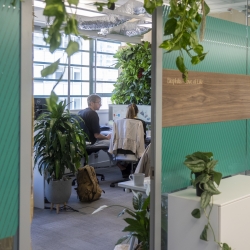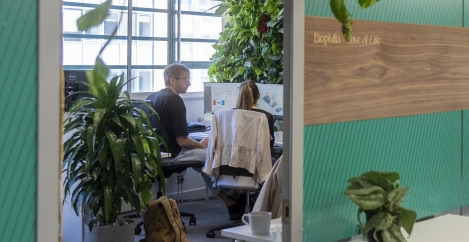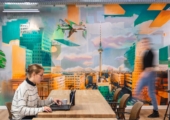April 26, 2023
Biophilic office design has a clear business case, report claims
 A new report, Reap What You Sow: Valuing Workplaces that Grow Good Ideas from PLP Labs sets out to explain the process of measuring and monetising the wellbeing and environmental value of biophilic office design. The report argues that in corporate real estate, the environment impacts the bottom line. PLP’s study – run in collaboration with academics from Loughborough University, the University of Reading, and Benholm claims to enable real estate clients to fairly evaluate the worth of investing in nature alongside other project costs.
A new report, Reap What You Sow: Valuing Workplaces that Grow Good Ideas from PLP Labs sets out to explain the process of measuring and monetising the wellbeing and environmental value of biophilic office design. The report argues that in corporate real estate, the environment impacts the bottom line. PLP’s study – run in collaboration with academics from Loughborough University, the University of Reading, and Benholm claims to enable real estate clients to fairly evaluate the worth of investing in nature alongside other project costs.
The report is the culmination of a year-long research project between PLP Labs, the research arm of PLP Architecture, and their research partners in both academia and industry that explores how to attribute monetary value to well-being and environmental quality in workplace design.
Biophilic office design can take the form of green walls, pot plants, skylights, water features or wood furniture. These features add value to the workplace; not only through improving air quality and aesthetics, but also tangibly impacting on employee health, creativity, productivity and satisfaction. Given employees are the largest cost for a business, the report explores to what extent biophilic design can save companies money by ensuring that staff are healthier and happier at work.
The report also highlights the importance of integrating biophilia into the architectural design process early and earmarking investment for it, so that the mechanical, electrical, and plumbing of the building can accommodate the plant life. Plants affect building conditions like humidity and air flow, therefore these conditions need to be accounted for.
An eight-week pilot study was conducted in PLP Architecture’s London studio, where employees worked in three different environments with varying degrees of views out and indoor greenery. The study used both qualitative and quantitative means to monitor the participants’ well-being and environmental quality during each scenario. Qualitative methods included questionnaires and interviews. Quantitative data on air quality, heart rate, steps, sleep quality, noise level, and EEG (brain waves) was collected through sensors and wearable technology.
A financial proxy was applied to the data collected from the post-occupancy evaluation, demonstrating the long-term value and potential of the well-being economy in monetary terms for stakeholders such as investors and developers.
Clear differences were found between the different degrees of biophilic workspace. The baseline scenario, with restricted views out and no indoor greenery, had the lowest net value of £11,627. The immersive scenario, with extensive views out and indoor greenery, was found to have the highest monetary gains in terms of well-being and environmental value, but also the highest capital investment, giving a net value of £16,830. The typical scenario, with moderate views out and indoor greenery found in a typical office set-up, had the largest net value of £22,211.
Measuring biophilic design in monetary terms enables designers and architects to make a business case for biophilic design, and enables investors, developers and occupiers to understand the long-term value and potential of the well-being economy. Not only this, the methodology used to measure the value of biophilic design can easily be translated to evaluate the value of other healthy and sustainable design choices.

























